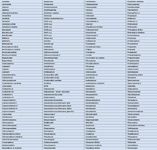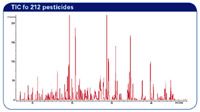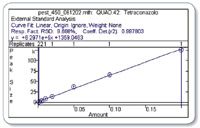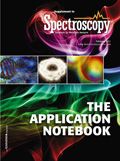Multi-Residue Pesticide Analysis Using a GC Triple Quadrupole Mass Spectrometer
Application Notebook
There are currently more than 1000 pesticides in use worldwide in the production of foodstuffs. There is a significant risk to human health and the environment due to increased pesticide use, poor agricultural practices and illegal use.
Martin Duff and Mario Voglino, Bruker Daltonics, Inc.
There are currently more than 1000 pesticides in use worldwide in the production of foodstuffs. There is a significant risk to human health and the environment due to increased pesticide use, poor agricultural practices and illegal use. Most countries have adopted strict regulations governing pesticide usage. Pesticide control laboratories are now under increased pressure to maximize both the range of pesticides detected in a single run and in complex matrices.
In this study, we describe the development of a multi-residue pesticide testing method utilizing a Bruker 320-MS triple quadrupole mass spectrometer that provides a fast, sensitive, and robust procedure for the comprehensive analysis of a large number of pesticides at 0.1 to 0.5 µg/kg levels in a single analytical run in food samples. At the completion of the study, the results obtained were analyzed to determine if they met the important SANCOquality control requirements for analysis of pesticides.

Figure 1: Listing of the 212 pesticides measured in this study.
Sample Preparation
A dispersive extraction procedure known as QuEChERS was used to prepare samples for analysis. QuEChERS is a simple and rapid technique, which is suitable for multi-residue pesticide analysis in a wide variety of food products. The homogenized samples were extracted with an organic solvent, agitated, and centrifuged for 1 min. The supernatant was transferred into a sample tube containing MgSO4 and Bondesil™ PSA, agitated for 20 s and then centrifuged. This extract was then transferred to an autosampler vial for direct injection into the Bruker 320-MS GC–MS-MS system.

Figure 2: GCâMS-MS chromatogram of 212 pesticides at concentrations ranging from 0.1 to 5 µg/kg.
GC–MS Conditions
Injector Temp. 70 °C ramped to 300 °C
Carrier Gas Helium at 1.2 mL/min, Electronic Flow Control (EFC), constant flow mode
Column FactorFour™ VF-5ms, 30 m × 0.25 mm × 0.25 µm (Bruker Part Number CP8944)
Column Temp. 60 °C, 2.0 min hold 20 °C/min to 150 °C 3 °C/min to 260 °C 30 °C/min to 290 °C, 6.0 min hold
Collision Gas Argon at 1.50 mTorr
Source Temp. 280 °C
Transfer Line Temp. 300 °C
Ionization 70 eV (EI positive mode)
Detector Voltage Extended Dynamic Range (EDR)
Instrumentation:
Bruker 320-MS triple quadrupole mass spectrometer
Bruker 450-GC gas chromatograph
Bruker 1079 PTV injector
Bruker MS Workstation Software
Results and Discussion
Samples containing a mixture of 212 pesticides were analyzed. List of the pesticides tested is shown in Figure 1. The rapid determination of all 212 pesticides was achieved with a single injection, monitoring at least two MRM transitions for each analyte to satisfy the SANCO quality control procedures. Figure 2 shows the full target ion chromatogram (TIC) for the 212 pesticides. Figure 3 shows a typical calibration curve for one the pesticides measured (tetraconozole).

Figure 3: Calibration curve for tetraconazole.
To further satisfy the SANCO quality control procedures, the Bruker MS Workstation software has the ability to measure and confirm ion ratios of the primary and secondary transitions automatically. Retention times of analytes are checked and confirmed at the same time. Figure 4 shows an example of a variety of user-selectable views of the data that enable the analyst to view primary and confirmatory transitions, calibration curves, a sample report, and spectrum comparison in a single window. This customizability has a significant effect on the speed at which samples can be processed, and helps to improve throughput in a busy analytical laboratory.

Figure 4: Data for tomato matrix matched solution at 0.05 µg/kg.
Conclusion
The highly sensitive Bruker 320-MS GC–MS-MS triple quadrupole mass spectrometer, controlled with MS Workstation software, can carry out the simultaneous analysis of 212 pesticides, including isomers and metabolites in a food matix. The results of this analysis were fully compliant with the SANCO quality control procedures.
Bruker Daltonics, Inc.
40 Manning Road, Billerica, MA 01821
tel. (978) 663-3660; fax (978) 667-5993
Website: www.bdal.com

High-Speed Laser MS for Precise, Prep-Free Environmental Particle Tracking
April 21st 2025Scientists at Oak Ridge National Laboratory have demonstrated that a fast, laser-based mass spectrometry method—LA-ICP-TOF-MS—can accurately detect and identify airborne environmental particles, including toxic metal particles like ruthenium, without the need for complex sample preparation. The work offers a breakthrough in rapid, high-resolution analysis of environmental pollutants.